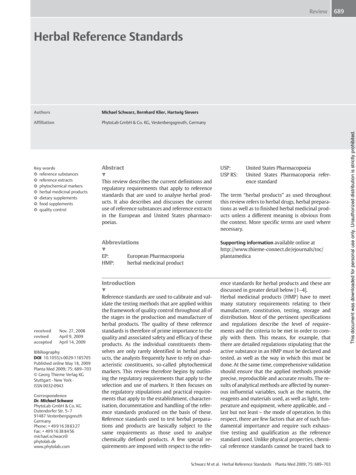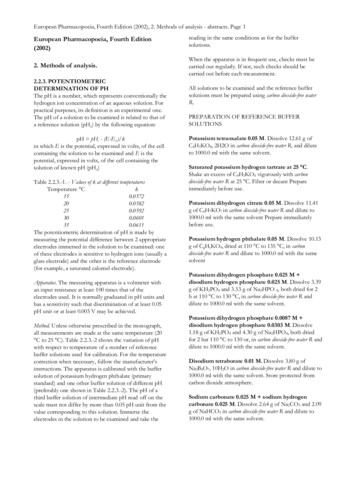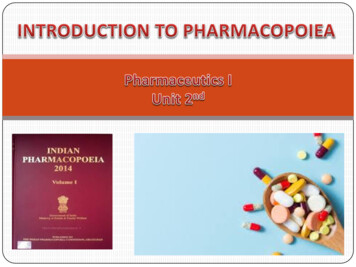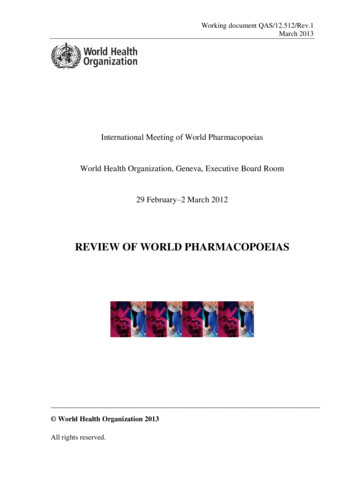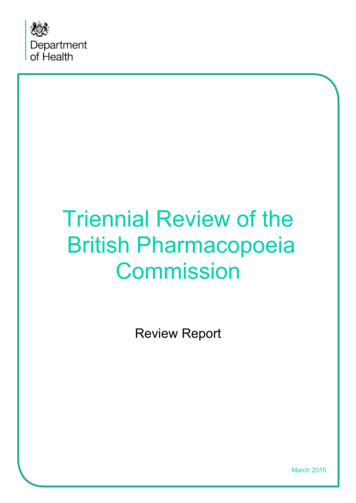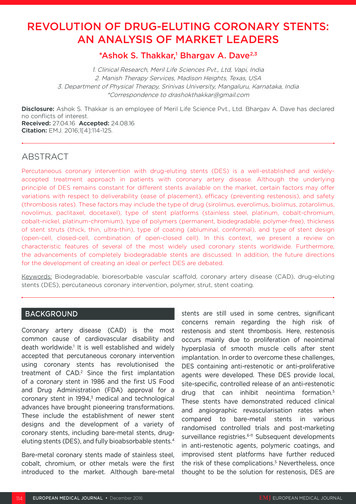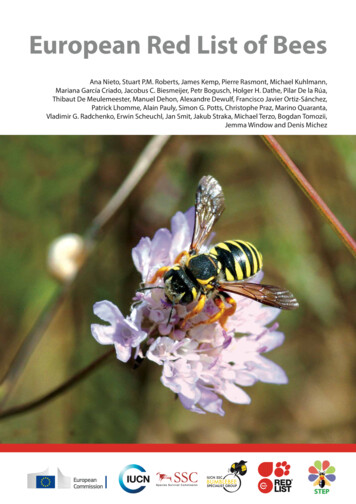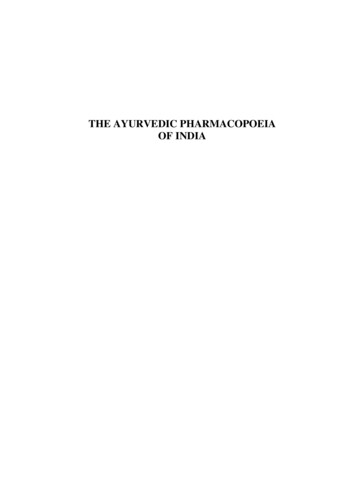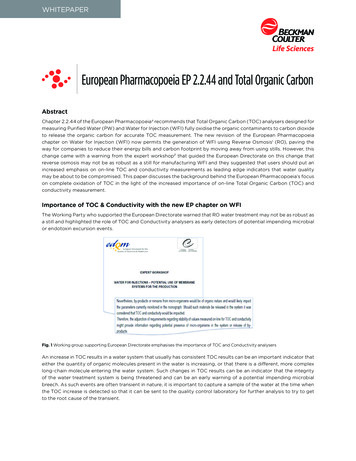
Transcription
WHITEPAPEREuropean Pharmacopoeia EP 2.2.44 and Total Organic CarbonAbstractChapter 2.2.44 of the European Pharmacopoeia4 recommends that Total Organic Carbon (TOC) analysers designed formeasuring Purified Water (PW) and Water for Injection (WFI) fully oxidise the organic contaminants to carbon dioxideto release the organic carbon for accurate TOC measurement. The new revision of the European Pharmacopoeiachapter on Water for Injection (WFI) now permits the generation of WFI using Reverse Osmosis1 (RO), paving theway for companies to reduce their energy bills and carbon footprint by moving away from using stills. However, thischange came with a warning from the expert workshop² that guided the European Directorate on this change thatreverse osmosis may not be as robust as a still for manufacturing WFI and they suggested that users should put anincreased emphasis on on-line TOC and conductivity measurements as leading edge indicators that water qualitymay be about to be compromised. This paper discusses the background behind the European Pharmacopoeia’s focuson complete oxidation of TOC in the light of the increased importance of on-line Total Organic Carbon (TOC) andconductivity measurement.Importance of TOC & Conductivity with the new EP chapter on WFIThe Working Party who supported the European Directorate warned that RO water treatment may not be as robust asa still and highlighted the role of TOC and Conductivity analysers as early detectors of potential impending microbialor endotoxin excursion events.Fig. 1 Working group supporting European Directorate emphasises the importance of TOC and Conductivity analysersAn increase in TOC results in a water system that usually has consistent TOC results can be an important indicator thateither the quantity of organic molecules present in the water is increasing, or that there is a different, more complexlong-chain molecule entering the water system. Such changes in TOC results can be an indicator that the integrityof the water treatment system is being threatened and can be an early warning of a potential impending microbialbreech. As such events are often transient in nature, it is important to capture a sample of the water at the time whenthe TOC increase is detected so that it can be sent to the quality control laboratory for further analysis to try to getto the root cause of the transient.
Clearly TOC and Conductivity analysers must be calibrated correctly and their calibration validated to ensure thatthey are working correctly in case a change in the water chemistry occurs. Equally, the intensity of the oxidising UVlamp needs to be monitored to ensure that it is strong enough to oxidise organic molecules sufficiently to extract allof the carbon atoms for accurate measurement.Although TOC analysers cannot determine what type of organic molecules are present in the water, they can beused to detect a change in the organic chemistry in the water as longer-chain organic molecules tend to exhibitdifferent oxidation profiles compared to short-chain organic molecules. If the TOC analyser is able to detect a changein oxidation profile when the water organic chemistry changes, this information combined with a change in TOCresults can indicate to the user the need to carry out an investigation to determine if the water system integrity ispotentially about to be compromised.TOC and ConductivityTOC analysis is a non-specific test, i.e. it is simply a measure of the carbon atoms found in any organic compound inthe water, it cannot identify exactly which type of organic molecule is present. A pharmaceutical-grade TOC analyseruses ultra-violet light (UV) to oxidise the organic molecules to release the carbon atoms present as carbon dioxide(CO2) and then measures the difference in water conductivity caused as the carbon dioxide dissolves into the water.TOC is to be calculated by measuring Total Inorganic Carbon (TIC) and Total Carbon (TC) and subtracting one fromthe other.TC – TIC TOCFig. 2 TIC and TC are measured and TOC is calculatedTOC results are reported in Parts Per Billion (ppb) which in this case is the mass (weight) of organic carbon per litreof water reported in mg/Litre. Longer-chain complex organic molecules may contain more carbon atoms than shortchain organic molecules, so equivalent numbers of the long- and short-chain molecules will be reported differently bythe TOC analyser, with reported TOC from the long-chain organics delivering higher TOC HCCOHC12H22O11HHOHHFig. 3 Organic molecule sucrose contains 12 carbon atomsTOC analysers that use conductivity to measure the organic carbon can also be used to detect inorganic contamination.However, the pharmacopoeias are very specific regarding calibration of conductivity analysers and the TOC analyserwould need to comply fully with their requirements. USP 645 is very clear that the conductivity meter cell constantmust be verified against a certified conductivity solution and that the meter electronics must be verified by the useof certified calibration resistor.Characterized By Ingenuity 2
External calibration resistorFig. 4 Beckman Coulter PAT700 direct conductivity analyser meter accuracy can be verified using a certified resistor as per therequirements of USP 645 Importance of Complete oxidationThe EP 2.2.44 chapter on TOC analysis4 emphasises the importance of complete oxidation of the organic contaminationin order to get an accurate TOC measurement.Fig. 5 Extract from EP 2.2.44 on TOC where complete oxidation is emphasisedAs organic carbon is measured by extracting it from the organic molecules and measuring it as CO2, either as a gasor in dissolved form using conductivity measurement, it is clear that the carbon present in the molecule must becompletely oxidised to CO₂, otherwise it simply won’t be measured.Implications of incomplete oxidationTOC analysers with short, fixed oxidation times can struggle to report TOC levels accurately. The InternationalConference on Harmonisation (ICH) is an expert working group with representation from the European, United Statesand Japanese Pharmacopoeias and in their ICH Q2, Validation Of Analytical Procedures⁵, tripartite guideline theyrecommend a system suitability test to determine the robustness of an analyser’s measurement. Should a TOC analyserwith fixed oxidation times be calibrated with TOC standards using relatively easy to oxidise sucrose, then it will likelynot report accurately if challenged with a relatively difficult to oxidise TOC standard such as SDBS as recommended inthe Japanese Pharmacopoeia⁶ chapter on TOC. The fixed flow-path and exposure time to the UV light will mean thatthe SDBS will not be fully oxidised and much of the carbon will remain un-measured.Some TOC analysers employ persulphate as well as UV light to extend their measuring range. In the presence of UVlight persulphate becomes a strong oxidising agent, enabling the TOC analyser to oxidise relatively large amounts ofTOC in a short time. However, in designs employing gas-selective membranes as part of the measurement cell thiscan present challenges. If too much persulphate is added, there is a danger that bubbles may form in the sample andthese bubbles can occlude the measurement membranes leading to under-reporting of TOC levels. Equally if too littlepersulphate is added, then the TOC will not be fully oxidised and, once more, the TOC analyser will under-report theTOC content of the sample. In this paradoxical situation, the analyser user somehow has to know in advance the valueof TOC in the sample so that they can configure the persulphate dosing correctly on the analyser before they carryout their TOC measurement.Characterized By Ingenuity 3
Longer chain, more complex organic molecules may create organic acids as intermediate species as they are beingoxidised down to CO2. Organic acids may contribute more strongly to the conductivity measurement than the finalCO2 from the completely oxidised organic, so failure to ensure complete oxidisation of the organic may result inan incorrect TOC value. Equally, failure to completely oxidise the organic may leave carbon atoms trapped in whatremains of the organic molecule structure, leading to under-reported TOC results.Fig. 6 intermediate species formed as the organic is oxidised may contribute more strongly to the sample conductivity than the finaloxidised carbonThe PAT700 TOC analyser from Beckman CoulterDesigned specifically for TOC analysis on PW and WFI, the PAT700 TOC analyser from Beckman Coulter employsvariable oxidation time combined with dynamic end-point detection to determine when the sample oxidation iscomplete. An aliquot of the water being sampled is trapped in the measurement cell. A single conductivity sensormeasures the conductivity of this sample which is representative of the TIC in the sample. A UV light is then turnedon to oxidise the organics in the sample. As the molecules are oxidised, the released organic carbon in the sampleturns to carbon dioxide, which dissolves and increases the conductivity of the trapped aliquot. The PAT700 monitorsthe change in conductivity of the sample and when the conductivity stops changing, the PAT700 knows that theanalysis end point has been reached and the sample has been completely oxidised. Now the sample contains both TICand TOC, i.e. TC. The TC conductivity is measured using the same conductivity sensor used to measure TIC and onesubtracted from the other to calculate TOC.Fig. 7 Beckman Coulter PAT700 uses dynamic end-point detection to ensure complete oxidation for accurate TOC analysis, even whenUV lamp intensity decreasesCharacterized By Ingenuity 4
By using a single sensor to measure both TIC and TC, the effects of any slight conductivity sensor drift over time onthe accuracy of the TOC calculation is eliminated as the conductivity sensor drift error would apply equally to bothTIC and TC measurements and thus cancel out.One of the weaknesses of the PAT700 is that it cannot be used on water samples not compliant with the pharmacopoeias’TOC limit test for PW and WFI because it does not use persulphate to extend its measurement range. It is limited to ameasurement range of 2,000ppb. However, the upside of this is, unlike TOC analysers that use persulphate, the userdoes not need to guess at the TOC levels in the PW and WFI in order to correctly set the dosing level of persulphate.As the oxidation time of the PAT700 is variable and controlled by dynamic end-point detection, the analysis of harderto oxidise materials such as SDBS recommended in the System Suitability Test in the Japanese Pharmacopoeia doesnot cause a problem: the PAT700 simply extends its analysis time, continuing to oxidise until it detects that the sampleconductivity has stopped changing and the oxidation is complete.The level of UV light being emitted from the UV lamp is measured to ensure that it is sufficiently powerful to oxidisethe sample and, in the event of a lamp failure, a second, standby UV lamp is turned on to ensure complete oxidation.Fig. 8 PAT700 ensures there is always sufficient oxidising UV light by measuring UV output and having auto-switching main andstand-by UV lampsCapturing TOC transient excursions for root-cause analysisTOC or conductivity contamination events can be transient in nature. For example, a water system that is experiencinggradual biofilm build up may experience TOC excursions just after sanitisation cycles as biofilm sloughs off the insideof the pipework. This excursion can quickly disappear, either by being diluted as it passes into the large quantity ofwater in the loop storage tank, or broken down by UV lamps connected to the pipework distribution network put inplace to discourage microbial build-up. However, this rapid disappearance may mask the increasing biofilm build upuntil there is a breakdown of system control and run-away microbial contamination. The PAT700 can be programmedto capture a water sample should a TOC excursion be detected so that the sample can be further analysed to get toroot cause.Fig. 9 Beckman Coulter PAT700 can capture a water sample to support root cause analysis if a TOC excursion is detectedCharacterized By Ingenuity 5
TOC as a lead indicator of water system contaminationOne of the additional advantages of dynamic end-point detection for complete oxidation in the PAT700 from BeckmanCoulter, is that it can provide an indication of the oxidation curve profile during each TOC analysis. A change in thetype of profile, combined with a change in TOC levels may provide insight into a change in the water system organicchemistry suggesting a potential degradation of the RO system integrity, prompting the user to investigate furtherand consider corrective action to prevent a large-scale contamination event and to put in place preventative measuresto avoid the recurrence of the problem in the future.Fig. 10 Changes in TOC oxidation profile curve can indicate potential degradation of water treatment integrity, prompting investigation toprevent a large-scale contamination eventConclusionAs leading-edge indicators of potential changes in water system health, on-line TOC and conductivity analysersare taking an ever increasing importance in preventing contaminated PW and WFI from mixing with expensivedrug product during manufacturing. The ability to report changes in water organic chemistry combined with TOCtransient excursion capture provides more support for root-cause investigations before the PW or WFI exceed thepharmacopoeial limits. Complete TOC oxidation to release all of the organic carbon as carbon dioxide, even withlong-chain, difficult to oxidise organic molecules as per the European Chapter 2.2.44 is paramount if accurate TOCmeasurements are to be made.Characterized By Ingenuity 6
References1. E uropean Pharmacopeia (Ph. Eur.) Commission press release 18th March 2016https://www.edqm.eu/sites/default/files/press release water for injections march 2016 0.pdf2. E DQM Expert Workshop, 24 March 2011 European Directorate for the Quality of Medicines & Healthcare (EDQM)7 allée Kastner, CS 30026 F -67081 Strasbourg3. US Pharmacopeia Convention, United States Pharmacopoeia, Rockville MD, USA and Council of Europe, EuropeanDirectorate for the Quality of Medicines & Healthcare, European Pharmacopoeia, Strasbourg, France4. Council of Europe, European Directorate for the Quality of Medicines & Healthcare, European Pharmacopoeia 8.0,01/2008:20244, Total Organic Carbon in Water for Pharmaceutical Use, Strasbourg, France5. International Conference on Harmonisation of Technical Requirements for Registration of Pharmaceuticalsfor Human Use VALIDATION OF ANALYTICAL PROCEDURES: TEXT AND METHODOLOGY ICH Q2 9, ICHSecretariat, Chemin des Mines, 1202 Geneva, quality/article/quality-guidelines.html6. he Japanese Ministry of Health Labour and Welfare, The Japanese Pharmacopoeia, Seventeenth Edition,TPharmaceuticals and Medical Devices Agency, Shin-Kasumigaseki Building, 3-3-2 Kasumigaseki, Chiyoda-ku,Tokyo 100-0013 Japan -development/jp/0019.html7. I nternational Society for Pharmaceutical Engineering, The ISPE Good Practice Guide: Ozone Sanitization ofPharmaceutical Water Systems, First edition July th August 2014]8. P harmaceutical and Healthcare Sciences Society, Best Practice for Particle Monitoring in Pharmaceutical Facilities,PHSS Technical Monograph No.16, First Edition 2008, ISBN 978-1-905271-15-39. M inistry of Health, Labour and Welfare, The Japanese Pharmacopoeia, 17th Edition, 1-2-2 Kasumigaseki Chiyoda-kuTokyo, 100-8916 JapanAuthor BiographyTony Harrison is a Compliance and Applications Specialist for Beckman Coulter Life Sciences. An experienced engineerin water system TOC, pH, conductivity and ozone analysis, Tony has spent the last twelve years in applied metrologyin the pharmaceutical and healthcare manufacturing industries. Prior to that, he worked for companies providingprocess control automation solutions for manufacturing industries.Tony was joint-editor of the ISPE Guide to Ozone Sanitization of Pharmaceutical Water Systems5 and was also chiefeditor of the PHSS Best Practice Guide for Cleanroom Monitoring 6.Tony is a well-known international speaker and has provided educational seminars on TOC, liquid particle counting,ozone sanitization for water systems and cleanroom monitoring in UK, France, Italy, India, Germany, Malaysia, China,USA, Scandinavia, Ireland, Hungary, Switzerland, Indonesia, Belgium, Greece, Switzerland, Turkey, Egypt, Columbia,South Africa and Denmark. 2018 Beckman Coulter, Inc. All rights reserved. Beckman Coulter, the stylized logo, and the Beckman Coulterproduct and service marks mentioned herein are trademarks or registered trademarks of Beckman Coulter, Inc.in the United States and other countries. All other trademarks are the property of their respective owners.For Beckman Coulter’s worldwide office locations and phone numbers, please visit “Contact Us” at beckman.comPART-3238WP01.18
European Pharmacopoeia EP 2.2.44 and Total Organic Carbon WHITEPAPER. Characterized By Ingenuity 2 Clearly TOC and Conductivity analysers must be calibrated correctly and their calibration validated to ensure that they are working correctly in case a change in the water che
